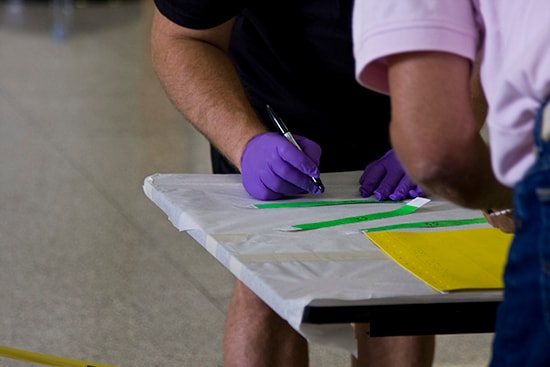Purpose
To provide information for professionals on implementing public health preparedness capabilities during radiation emergencies.

Clinical laboratory testing
Biological specimens can provide a powerful diagnostic tool for assessment of internal contamination and radiation exposure. Public health and hospital laboratories may be needed to analyze blood samples (CBC with differential white cell count). Collection of urine or blood specimens for analysis may take place in a hospital or other medical facility; or in the field at a community reception center as a part of the population monitoring process.
To get started: Laboratory Information for Radiation Emergencies
Public health surveillance and epidemiological investigation
State and local agencies should establish a registry as early as possible after a radiation emergency. This registry will be used for short-term medical follow-up or long-term health monitoring of affected people. The long-term monitoring process involves observing and recording any health effects that could be related to radiation exposure. Establishing the registry is a part of population monitoring operations.
To get started: Community Reception Center Electronic Data Collection Tool (CRC eTool)
Community preparedness
Making pre-event information about radiation emergencies available to community partners and the public will enhance community preparedness. For example, all-hazards awareness training could incorporate protective action messages for radiation emergencies, such as the "get inside, stay inside, and stay tuned" message.
Medical countermeasure dispensing
There are some medical treatments available for limiting or removing internal contamination. These treatments only work for certain types of radioactive materials. Medical professionals will have to determine if treatments are needed. For treatment to be effective, it must be administered quickly in order to have the best chance at mitigating adverse health effects.
To get started: Medical Countermeasures for Radiation Exposure and Contamination
To get started: Radiological Terrorism: Medical Response to Mass Casualties
Medical material management and distribution
In addition to medical countermeasures, there may be other medical material needs following a radiation emergency related to burns, trauma injuries, or other scenario-specific needs.
To get started: Medical Countermeasures for Radiation Exposure and Contamination
Non-pharmaceutical interventions
Non-pharmaceutical interventions such as getting inside a building, taking a shower or changing clothes, and sheltering-in-place can be very effective in reducing potential health effects of a radiation emergency. Population monitoring operations and public information are two examples of how non-pharmaceutical interventions could be implemented.
Emergency operations coordination
The Nuclear Radiological Incident Annex (a part of the National Response Framework) outlines the response activities for a radiation emergency. Coordinating with emergency support functions to provide guidance regarding health and safety precautions, and conducting medical response operations will be especially important.
Emergency public information and warning
Effective and timely communication will play a vital role during a radiation emergency. Communication after a radiation event must address the public's concerns using simple and concise messages. Radiation is an unfamiliar hazard to many, and understanding the threat, as well as knowing what protective measures to take will be a challenge for communicators.
Information sharing
Sharing information regarding health and safety is especially important after a radiation emergency. Many response agencies will need information regarding safe operational areas, responder precautions, and the status of healthcare infrastructure. For some types of radiation emergencies, law enforcement agencies may require assistance and collaboration with health and medical agencies to assist in investigations and evidence collection.
To get started: Radiological/Nuclear Law Enforcement and Public Health Investigation Handbook
Fatality management
Depending on the scale of the radiation emergency, an event could result in radioactively contaminated decedents, through surface contamination, internal contamination, or shrapnel on or in decedents' bodies. Assisting in fatality management operations would include coordinating proper and safe recovery and handling of contaminated decedents.
To get started: Guidelines for Handling Decedents Contaminated with Radioactive Materials
Mass care
Mass care operations, including public sheltering, during a radiation emergency will present unique needs that require additional guidelines for shelter operations. Decontamination, registration and tracking, and risk communication are areas of mass care that may require specialized planning and training.
To get started: A Guide to Operating Public Shelters in a Radiation Emergency
Medical surge
Managing medical surge in a radiation emergency will include facility preparation, surge capacity, health care provider safety, patient decontamination, triage and the medical management of life threatening injuries. Life-saving medical care should never be postponed because of concerns about contamination.
To get started: Radiological Terrorism: Medical Response to Mass Casualties
Volunteer management
Following a radiation emergency, volunteers may be called upon to assist with various response activities, including population monitoring. Volunteers may assist with entering registry information, directing people to additional services, or other support services. Some volunteers may have a radiation background and could assist with screening or other more technical tasks.
Responder Safety and Health
Protocols to protect responder safety and health will depend on the responder's role in the response to a radiation emergency. Safety officers will be able to provide specific worker protections and precautions based on the situation. These could include barrier protection methods, such as N-95 respirators and gloves, as well as using radiation monitoring equipment, such as dosimeters or detection instruments.
Community recovery
Recovery from a radiation emergency could take a long time. There may be ongoing environmental cleanup and a need to assist those who may have been contaminated by or exposed to radioactive material. Addressing the psychological impact of radiation disasters will also be a key part of recovery efforts.
